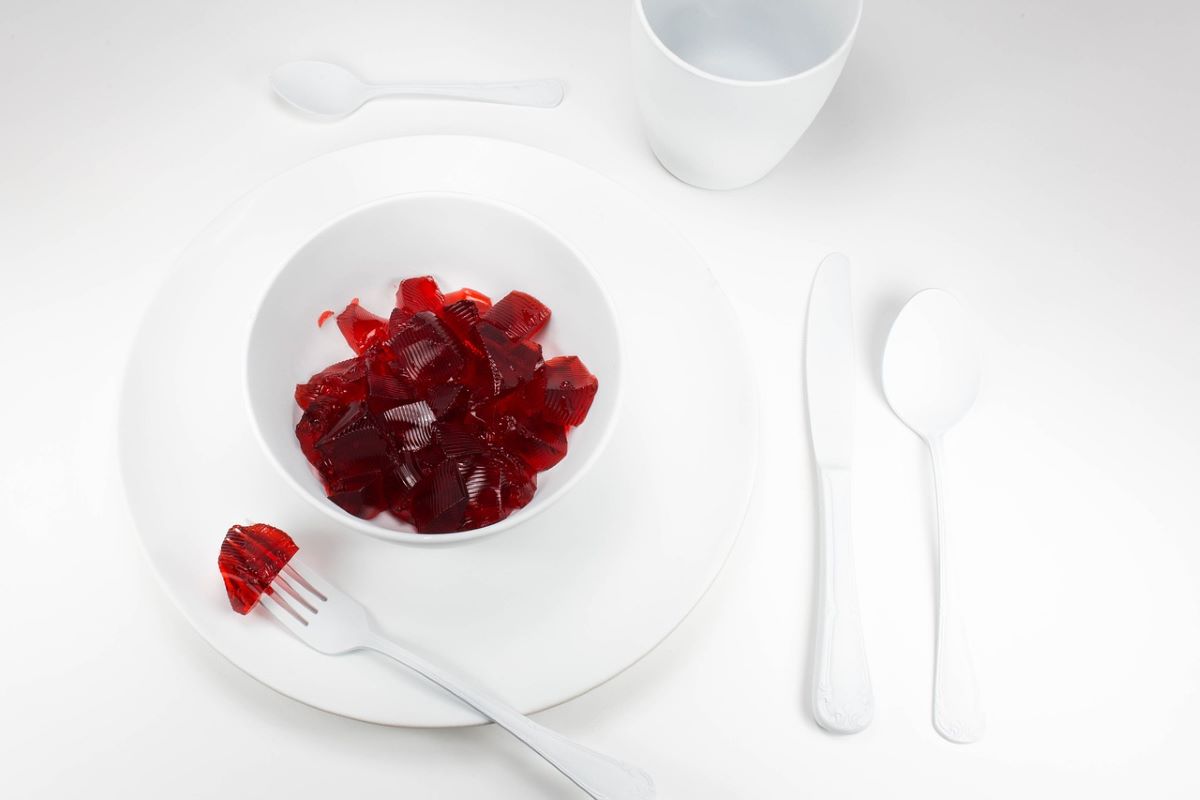When buying ingredients for your cooking, you probably don’t jump to decide on gelatin as a pasta additive! Gelatin is just one of the numerous food additives stocked in American supermarkets designed to improve food taste, texture, and appearance. What is made of gelatin, though? After a quick Google search, it can be confusing to get to the root of this ingredient. But never fear — we’re here to give you our definitive answer.
Gelatin is a protein product derived from animals and used in food and beverage manufacturing, cosmetics, and other industries. It is made by cooking the bones, hides, and skins of animals in the water, which creates a mixture of collagen with some fat and water. This mixture is then dried and ground into a powder.
The resulting gelatin powder has many valuable properties, including the ability to absorb up to ten times its weight in water. These properties make it ideal for use in desserts that need to set or thicken (such as Jell-O), soups and sauces, yogurts and puddings, candies and gummy bears, marshmallows, ice cream, coffees, and teas (instant coffee is often made with gelatin or agar).
It also includes cake frosting and icing, beer brewing, capsules for supplements and drugs (including vitamins), photography film, paintballs, ceramics, glue for woodworking projects like bookbinding or scroll making, plastics manufacturing (including photographic film), shampoos, and hair care products, skin creams and lotions, toothpaste manufacturing, textiles manufacturing (including silk screening), candles. The list goes on!
Is All Gelatin Made Of Animals?
In the United States, gelatin is almost always derived from animal products. The process for making gelatin begins with boiling the bones and skin of animals to extract collagen, which then gets separated and dried into powder form. Some vegetarian options are available that use seaweed or other plants as a base instead of collagen, but in general, you should expect gelatin to be an animal product.
Gelatin is a colorless, flavorless product that is made from animal collagen. This collagen comes from the connective tissues, bones, and skins of animals like cows, pigs, and chickens.
The purpose of gelatin is to thicken any liquid it’s added to. Gelatin has a jiggly texture when it’s thoroughly cooled. It’s used in jellies and gummies, but not all gummies are made with gelatin. Some are made with fruit pectin or agar (a substance derived from algae). To make gelatin, collagen is boiled in water to create a thick mixture that can be used in various recipes.
Is Gelatin Good For Health?
Gelatin contains collagen, an essential structural protein found in your skin, bones, muscles, and tendons. Collagen gives strength to these body areas and helps them maintain their shape.
Collagen has been shown to have many health benefits, including improving skin elasticity, reducing inflammation in the gut, increasing muscle mass, and improving bone health.
One study found that collagen supplements increased muscle mass by 8.8% over six months in older adults with sarcopenia (age-related muscle loss).
Other studies have found similar benefits for bone health. Gelatin may also help reduce joint pain and improve flexibility in people with osteoarthritis.
However, there are some downsides to gelatin. It does not contain any vitamins or minerals and may be high in sodium if you buy it from the supermarket.
Is There A Vegetarian Alternative?
Yes, there is a vegetarian alternative to gelatin. Gelatin is derived from the collagen in animal bones and tissues, which means that it is not vegetarian-friendly. Plenty of other substances can be used to set food products similar to gelatin, such as agar-agar powder, carrageenan, or xanthan gum. It is also possible to produce your gelatin from plant-based sources such as seaweed or fungus.
What Animals Are Used To Make Gelatin?
The animals used to make gelatin are cows, pigs, and fish. Gelatin is an animal protein derived from collagen, the main protein found in the connective tissue of most animals. While gelatin can be made from a wide range of animals, cow and pig bones are most commonly used because they contain the highest collagen concentration. Fish gelatin is also used as an alternative to beef gelatin.
Gelatin is used in a wide variety of food products, including desserts, candies, fruit snacks, and non-food applications such as photographic film, vitamins, and pharmaceuticals. Gelatin makes up 10 percent or less of each recipe using it, which means that minimal amounts of the entire animal are used to produce it.
Also Gelatin is not considered a meat product because it does not contain muscle. It does not have any live cells or blood either.
Is Gelatin Safe To Use?
Gelatin is safe to use within reason and in moderation. There are no significant side effects associated with it, and it can be beneficial in many ways. However, people with certain digestive conditions or those who are vegan should not consume gelatin.
Gelatin can be found in many products, including skin care items, gummy candies, marshmallows, and even dog foods. It is most commonly used to thicken and solidify other ingredients, though it is also a good source of protein. Gelatin has also been shown to help people with osteoarthritis manage their symptoms better by reducing joint pain and stiffness.
While it is safe to use, some people should not consume gelatin. People with certain digestive conditions like IBS should avoid gelatin because the fiber content may cause symptoms to worsen. Vegans are also unlikely to consume gelatin because it comes from pigs and cows.
Otherwise, gelatin is relatively safe for most people. Since there are no significant side effects associated with its consumption, you can enjoy your favorite jello snack without worry!
Conclusion
Using gelatin for cooking is a great idea. Indeed, it is an exquisite additive to various dishes. It has multiple health benefits as well. We all know that gelatin is good. Gelatin was first created from the bones of animals and fish to create a protein-based food supplement that can be made into jellies, puddings, or anything else with a thick consistency.
You May Like These Articles As Well:
 Being Human
Being Human





